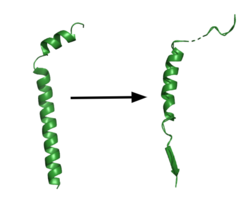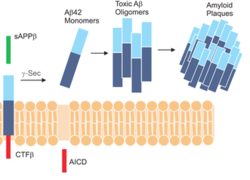Sandbox Reserved 1621
From Proteopedia
(Difference between revisions)
| Line 7: | Line 7: | ||
===Overall Structure=== | ===Overall Structure=== | ||
| - | GS is composed of 20 transmembrane components (TMs) and has four separate protein subunits: '''<font color='lightsteelblue'>Nicastran (NCT)</font>, <font color='lightgreen'>Presenilin (PS1)</font>, <font color= 'pink'>Anterior Pharynx-defective 1 (APH-1)</font>,''' and '''<font color='khaki'>Presenilin Enhancer 2 (PEN-2).</font>'''<ref name="Bai_2015">PMID:26623517</ref> These subunits are stabilized as functional GS by hydrophobic interactions and | + | GS is composed of 20 transmembrane components (TMs) and has four separate protein subunits: '''<font color='lightsteelblue'>Nicastran (NCT)</font>, <font color='lightgreen'>Presenilin (PS1)</font>, <font color= 'pink'>Anterior Pharynx-defective 1 (APH-1)</font>,''' and '''<font color='khaki'>Presenilin Enhancer 2 (PEN-2).</font>'''<ref name="Bai_2015">PMID:26623517</ref> These subunits are stabilized as functional GS by predominately hydrophobic interactions and four [https://en.wikipedia.org/wiki/Phosphatidylcholine phosphatidylcholines]. |
<scene name='83/832945/Nct_subunit_shown/1'>NCT</scene> has a large extracellular domain and one TM. NCT is important to substrate recognition and binding. | <scene name='83/832945/Nct_subunit_shown/1'>NCT</scene> has a large extracellular domain and one TM. NCT is important to substrate recognition and binding. | ||
| - | <scene name='83/832945/Ps1_subunit/1'>PS1</scene> serves as the active site of the protease and contains | + | <scene name='83/832945/Ps1_subunit/1'>PS1</scene> serves as the active site of the protease and contains nine TMs, each varying in length. The site of autocatalytic [https://en.wikipedia.org/wiki/Bond_cleavage cleavage] is located between <scene name='83/832945/Tm6_and_tm7/2'>TM6 and TM7</scene> of PS1 and a major conformational changes take place in the PS1 subunit upon substrate binding. |
<scene name='83/832945/Aph-1_subunit/1'>APH-1</scene> serves as a scaffold for anchoring and supporting the flexible conformational changes of PS1. | <scene name='83/832945/Aph-1_subunit/1'>APH-1</scene> serves as a scaffold for anchoring and supporting the flexible conformational changes of PS1. | ||
| - | Activation of the active site is dependent on the binding of <scene name='83/832945/Pen2_subunit/1'>PEN-2</scene>. PEN-2 is also important in maturation of the enzyme.<ref name="Yang">PMID:28628788</ref> | + | Activation of the active site is dependent on the binding of <scene name='83/832945/Pen2_subunit/1'>PEN-2</scene>. PEN-2 is also important in maturation of the enzyme.<ref name="Yang">PMID:28628788</ref> Finally, the five <scene name='83/832945/Phosphotidylcholines/3'>phosphatidylcholines</scene> reside in the following subunit interfaces between: PS1 and PEN-2, APH-1 and PS1, APH-1 and NCT. |
== Structural highlights == | == Structural highlights == | ||
Revision as of 13:43, 14 May 2020
Gamma Secretase
References
- ↑ 1.0 1.1 1.2 Bolduc DM, Montagna DR, Seghers MC, Wolfe MS, Selkoe DJ. The amyloid-beta forming tripeptide cleavage mechanism of gamma-secretase. Elife. 2016 Aug 31;5. doi: 10.7554/eLife.17578. PMID:27580372 doi:http://dx.doi.org/10.7554/eLife.17578
- ↑ 2.0 2.1 2.2 2.3 2.4 2.5 2.6 2.7 2.8 Zhou R, Yang G, Guo X, Zhou Q, Lei J, Shi Y. Recognition of the amyloid precursor protein by human gamma-secretase. Science. 2019 Feb 15;363(6428). pii: science.aaw0930. doi:, 10.1126/science.aaw0930. Epub 2019 Jan 10. PMID:30630874 doi:http://dx.doi.org/10.1126/science.aaw0930
- ↑ 3.0 3.1 Bai XC, Rajendra E, Yang G, Shi Y, Scheres SH. Sampling the conformational space of the catalytic subunit of human gamma-secretase. Elife. 2015 Dec 1;4. pii: e11182. doi: 10.7554/eLife.11182. PMID:26623517 doi:http://dx.doi.org/10.7554/eLife.11182
- ↑ 4.0 4.1 4.2 4.3 Bai XC, Yan C, Yang G, Lu P, Ma D, Sun L, Zhou R, Scheres SH, Shi Y. An atomic structure of human gamma-secretase. Nature. 2015 Aug 17. doi: 10.1038/nature14892. PMID:26280335 doi:http://dx.doi.org/10.1038/nature14892
- ↑ 5.0 5.1 5.2 5.3 Yang G, Zhou R, Zhou Q, Guo X, Yan C, Ke M, Lei J, Shi Y. Structural basis of Notch recognition by human gamma-secretase. Nature. 2019 Jan;565(7738):192-197. doi: 10.1038/s41586-018-0813-8. Epub 2018 Dec, 31. PMID:30598546 doi:http://dx.doi.org/10.1038/s41586-018-0813-8
- ↑ Bachurin SO, Bovina EV, Ustyugov AA. Drugs in Clinical Trials for Alzheimer's Disease: The Major Trends. Med Res Rev. 2017 Sep;37(5):1186-1225. doi: 10.1002/med.21434. Epub 2017 Jan 13. PMID:28084618 doi:http://dx.doi.org/10.1002/med.21434
- ↑ Kumar D, Ganeshpurkar A, Kumar D, Modi G, Gupta SK, Singh SK. Secretase inhibitors for the treatment of Alzheimer's disease: Long road ahead. Eur J Med Chem. 2018 Mar 25;148:436-452. doi: 10.1016/j.ejmech.2018.02.035. Epub , 2018 Feb 15. PMID:29477076 doi:http://dx.doi.org/10.1016/j.ejmech.2018.02.035
Student Contributors
Daniel Mulawa
Layla Wisser


